
OCEAN CITY — The first of what will likely be many migrating seals was observed on a north Ocean City beach last weekend, providing an opportunity to remind curiosity seekers and photographers to observe and enjoy the annual visitors from a safe distance.
“Ocean City had its first seal sighting of the season on the beach last Saturday as a young harbor seal hauled out for a much needed rest before heading back to sea to continue its journey,” said the Maryland Coastal Bays Program’s Sandi Smith this week. “As seal populations expand, seals are being found in southeastern states with increasing regularity and Ocean City gets it fair share during the winter months.”
While it is not uncommon to see seals on the beach in Ocean City, or the islands in the coastal bays, or even on docks and piers during the winter, last weekend’s sighting seemed a little premature.
“This is a little early,” said Smith. “We anticipate seeing them in late December through January and February and even into early March, but this little guy appeared a little earlier than usual.”
The seal discovered on a north Ocean City beach last Saturday lingered for a day or so before returning to the sea. While some are injured or ill and require rescue and rehabilitation, last week’s visitor was likely taking a break from the storm-tossed seas.
“The Ocean City Police Animal Control Officer responded and after consulting with the National Aquarium rescue people, it was decided no interaction was needed,” said Smith. “It was discovered in an area not highly frequented this time of year and the seal was plump and happy and appeared to be in good health, so no mediation efforts were needed on our part. The seal was monitored until it decided to continue on and do its thing.”
Smith took the opportunity to urge residents and visitors to enjoy the cute creatures from a safe distance, for their own sake and the sake of the animals.
“A seal’s cute puppet-like face and lumpy body make them adorably appealing and seemingly approachable,” she said. “However, an up close and personal encounter can harm the seal and you or your dog.”
When a seal lies on a beach, it is hauling out, a normal behavior. They temporarily leave the water between periods of foraging activity for sites on land. Hauling out is necessary in seals for mating, giving birth, predator avoidance, thermal regulation, social activity, parasite reduction and simple rest. The seals spotted in the resort area each winter are typically hauling out for rest, but can often be in distress or otherwise ill or injured. Whatever the reason, Smith said they should be enjoyed from afar and left alone by the public. Only when a seal is injured or ill does Animal Control, the MCBP and ultimately the National Aquarium’s Marine Animal Rescue Program (MARP) intercede.
“They haul out to rest, so human interaction will encourage them to retreat back into the water, which results in stress and fatigue,” said Smith. “More importantly, they can bite. They are mammals and many viruses and serious infections can be transmitted to humans and pets.”
The seals are protected by the Marine Mammal Protection Act and it is against the law to touch, feed or otherwise harass them. The law requires residents and visitors to maintain a distance of at least 50 yards when observing an enjoying the winter visitors and resist the temptation to get up close for pictures. In addition, those who come upon a beached seal are urged not to post pictures divulging the location on social networks in order to avoid large crowds gathering.
“Although a seal may not appear to be disturbed if you approach them closely, this is far from reality,” said Smith. “Close encounters pose serious trauma to an exhausted wild animal seeking rest and refuge on our beaches.”
